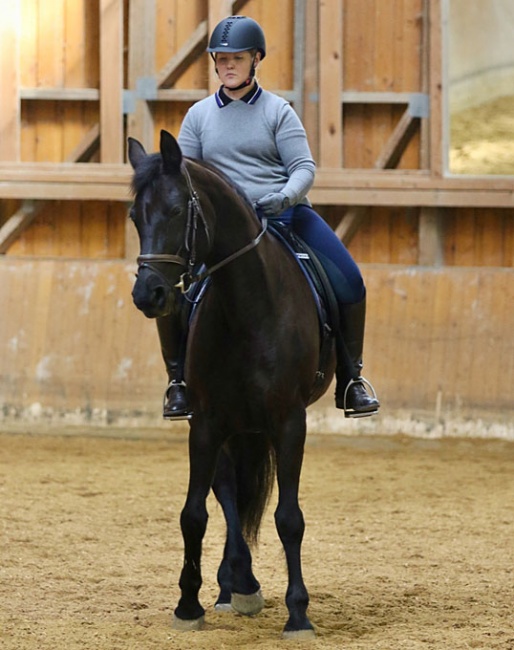
When we ride and train a horse, whatever we do, we should aim for a good movement. What can we understand under this term?
Good movement is natural and balanced, it both looks and feels easy. Only balance allows variation between different gaits, different exercises and different postures: from collected to forward downward position and in all directions. Variable postures help to develop the horse and his balance in different ways which then enables efficient force transmission in synchronization with all structures of the body. When movement works well without compensations, forces are appropriately distributed to different structures – this helps to achieve healthier movement and as a result minimize risk for overloading.
Active and calm movement helps us maintain and develop the range of motion. Soft, relaxed movement creates suppleness when used together with activity. It should feel easy and free in all directions and it is beneficial to have a routine where you go through different exercises to notice and work on possible differences already in an early phase of your daily training.
To achieve “good movement” in the daily training, there are some basic exercises which can serve as part of a warm up or the beginning of an easy checklist. This kind of work can also be called “lubricating” one and furthermore allows us to work on the horse’s general balance and the fine-tuning of the way the horse moves. As walk is a slower gait and easy for the rider to sit, it is ideal for getting to feeling what is happening in your horse.
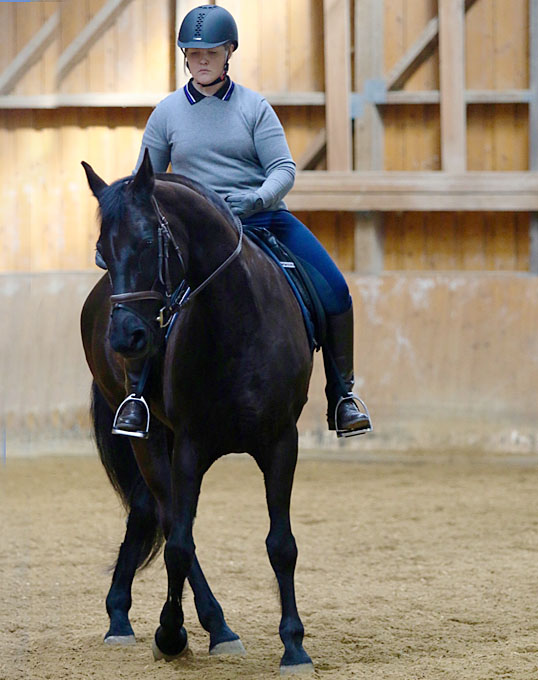
In a good walk the horse feels active, he is not in a hurry and maintains the walk the rider asked of him. The rider can sit in a relaxed way with supple shoulders, and a core that allows the horse to move its back without the rider trying to push the horse forward. The rider’s legs rest on the saddle and the hips, knees and ankles remain supple. The hands keep a light contact with the mouth of the horse so that the horse has possibility to move his neck in the rhythm of the walk which enables the whole body to move as relaxed as possible.
Balance and posture
To test and practice balance let the horse seek the neck slightly forward down and then elevate the neck gently again, maintaining the same walk all through the exercise. Lowering the head and neck puts the horse more on his forehand and it affects the placement of centre of mass of the horse. This is suitable to be used as a variation technique for a short period of time. This exercise is targeted especially on the shoulder girdle and cervical muscles, and is useful for creating better support, balance and lightness of the forehand when the horse is moving with the head and neck in a neutral position that is the normal position and the frame you find comfortable for this particular horse. This also affects the spine from the cervical to the pelvic area, when the posture is changed towards forwards-downwards. When neck is lowered, it affects also the ligament nuchae and the supraspinous ligament, together with musculature of the back and the abdominal wall.
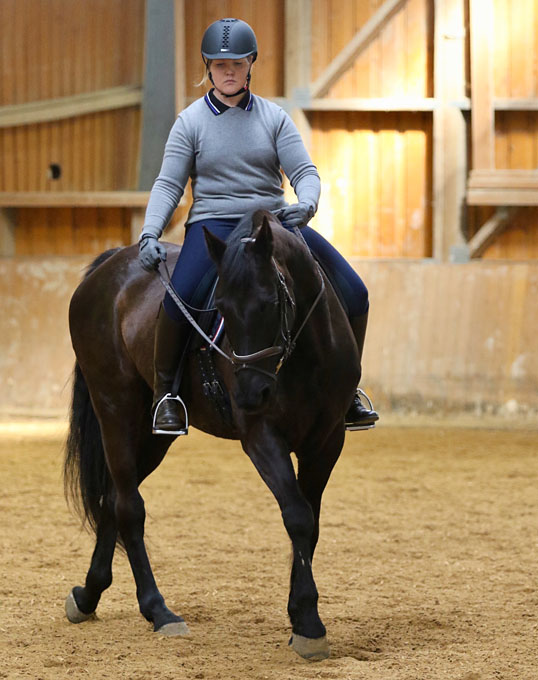
If the balance of your horse is rather difficult, the horse may try to rush or pull the head forward in this exercise. Some horses also lose activity when the balance is affected. If that is the case, avoid pushing the horse forward with your seat. Instead ask the horse to move forward and prepare the exercise again, asking just for a little lowering and elevating of the neck. It is enough if you can get a feeling that the horse is following the direction where you are giving with the rein.
Enlarging the circle
Start in a calm, active walk and ask the horse to bend and give a lateral flexion on the circle. Then move the shoulders out on the circle to enlarge your track. Look where you are going and maintain the same activity in walk through the outwards steps. Take care of the balance of the outside shoulder with your outside rein so that the horse will not lean outwards. Use a half-halt, and then let your outside rein remain soft and elastic. Keep your legs long and the hips supple. If your inside leg is asking the horse to assist bending or helping the horse to step out, and the horse is not reacting to it, make sure you are not holding your leg towards the horse for many steps. If this is the case, your hip is restricting the movement because the holding position of the leg creates tension on the rider’s hip, and horse tends to take this as a request to slow down. You can make the leg aid more effective by using correct timing, by touching with the leg or the whip the moment the horse is about to lift the inner hind leg. Also make sure your half halt from the outside rein was clear enough, if the leg aid is not going through promptly. It may also be helpful that you think a little towards the horse’s outside shoulder with one hip. It is good to note that for some riders it is easier to think of the outside hip, when some find it easier to use the idea of inside hip or even seat-bones. It is a very slight aid thinking to the direction you want to go, so you can choose the one that works best for you, as long as you are not trying to push the horse out with your seat. The horse may also try to lean outwards which makes it more difficult to sit straight. To correct this take care of the balance of the outside shoulder. You can also direct the rein slightly upwards to help the balance, but whenever you lift the rein make sure you are not acting backwards and that you soften your fingers immediately after. The horse should keep a very soft contact through the movement and walk actively out with supple side steps.
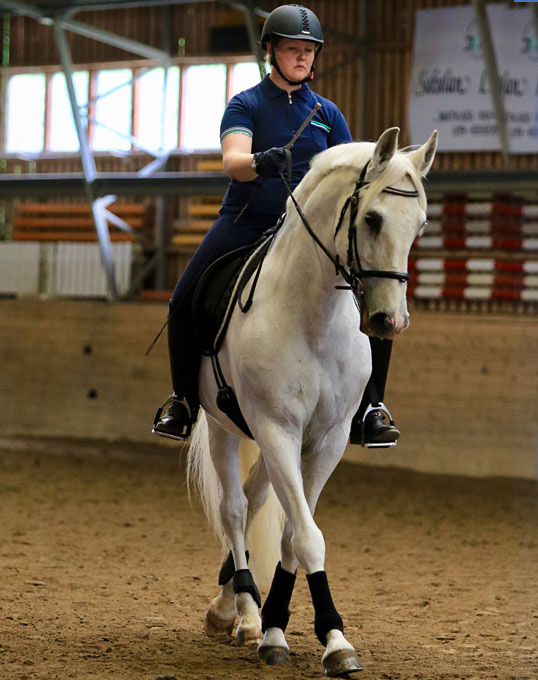
Shortening the circle
Look where you are riding along the circle now you can think very slightly towards the horse’s inside shoulder with your hips. Start with a half-halt on the new inside rein and position your outside leg behind the girth. Then let your legs remain as supple as possible. This movement helps to balance the horse, and when it is stepping inwards and crossing his front limbs it will create a lifting effect on the withers area, if it is done correctly. The inside hind-leg becomes active and the horse remains light and supple in the front. The outside rein can be used gently and indirectly towards horse’s neck, pointing towards the inner ear, but without the hand crossing over the neck. The inside rein helps to bend the horse and it regulates the lateral flexion of the poll. The rein must remain soft and it can also be used slightly inwards as a leading. In this movement the focus is on the activity of inner hind leg, so that the horse is flexing this limb slightly. This movement can be used as a spiral to shorten the circle all the way to turn on the haunches. It also serves well in preparing the canter departure because of its positive effect on the balance. If the horse seems to be pushing inwards, make sure the inner shoulder is waiting and your half-halt was successful. If the horse seems not listen to the outside leg to bring the hindquarters in, make sure you are not trying to hold or push the leg against the horse. If the horse tends to become “sticky” in the contact, make sure you are not trying to hold the reins too tight. Keep your fingers soft and progressively shorten the circle. Continue with some good steps, let the horse change the posture and change the rein. This exercise is good for helping the horse to find balance and activity, and preparing collection. These basic exercises can also be done in trot and canter.
Conclusion
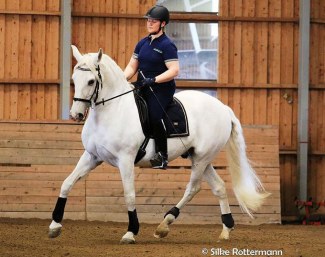
by Niina Kirjorinne and Silke Rottermann
Related Links
Functionality in Equitation: Fascia and Movement
Meet Niina Kirjorinne, Classical Dressage Rider and Physiotherapist
Effect of Noseband Positioning to Fascial and Neural Dynamics of the Head